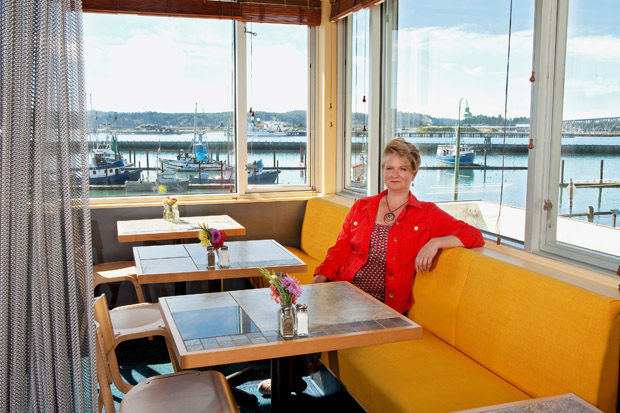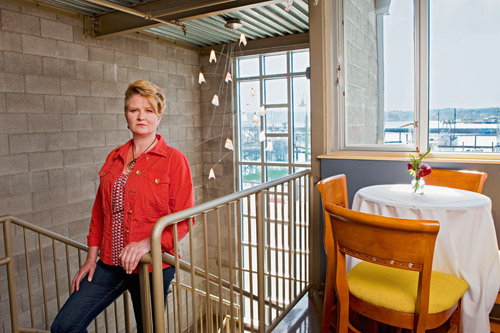BY LORI TOBIAS
Business has been good to Laura Anderson, leading some to suggest she must be awfully lucky to find such success in a business notorious for failure. But luck’s had little to do with it.

BY LORI TOBIAS | PHOTO BY SHARON BIDDINGER
Mid-afternoon at the Bayfront Local Ocean Seafoods in Newport finds guests overflowing onto the sidewalk, hanging out and watching the fishing fleet come and go. A wait for a table here is the norm, but no one seems to mind.
Business has been good to Laura Anderson, leading some to suggest she must be awfully lucky to find such success in a business notorious for failure. But luck’s had little to do with it.
Rather, Anderson has relied on foresight, creativity and a unique partnership with the local fishing fleet to drive sales this year to nearly $3 million, proof that a restaurateur can buy locally sustainable seafood in large volume without committing financial suicide.
It’s not just good for Anderson but for the local economy, which benefits from the $1.2 million her staff takes home in tips and wages, the fishing fleet, the environment and, of course, fans of fresh, locally caught seafood.
“My business is not just about serving another plate of fish and chips,” says Anderson, 43. “I consider us seafood leaders, on the forefront of the sustainability movement, actively educating consumers. Oregon boasts some of the best-managed fisheries in the world. That creates a real sense of pride for our fleet, our staff and our customers.”
Terry Thompson, a Lincoln County Commissioner and lifelong fisherman, skippers one of the 50 vessels Anderson buys from. She understands what quality seafood is, Thompson says.
“She is unusual,” he says. “She is a woman who has at-sea experience, having fished with her father. She’s taken the idea of locally produced seafood and allowed it to go to the public, direct from the boat into her store and onto her table.”
Anderson never set out to own a restaurant, but she earned a master’s degree in marine resource management at Oregon State University.
Twelve years ago, an investor asked her help in finding a developer for an empty Bayfront lot. That led Anderson to fisherman Al Pazar, who operates Florence’s Krab Kettle. Pazar suggested a similar business might work in Newport.
When Anderson sought advice on the venture from her father, a second-generation fisherman, he gave the tip of a lifetime. “He said, ‘Go 50/50 with him.’ I said, ‘Dad, I am just out of grad school. I’m broke.’ He said, ‘That doesn’t matter because you are the one who is going to put all your blood, sweat and tears into it.’”
Three years ago, Anderson bought Pazar’s share. From the beginning, she’s operated the combined restaurant and market on one central premise: “Our whole brand is centered around buying as locally as possible,” Anderson says. That means, unlike other seafood restaurants, she can’t use farmed shrimp or Alaska sockeye salmon.
“I could, but it wouldn’t pass my personal red-face test,” Anderson says. “We get so much salmon right here, I wouldn’t need to purchase from far away.” But she is open to buying seafood, such as halibut, from fishermen at greater distances if it isn’t plentiful here.
Keeping it local comes with all the advantages most people already know: a reduced carbon footprint, food security and safety and recycling dollars into the local economy. But rather than ask “Why local?,” Anderson suggests a different question.
 “Why import?” she asks. “We have access to some of the most valuable natural capital in the world. Oregon seafood is sought worldwide for both quality and sustainability. When you’ve got the best right here, why go anywhere else?”
“Why import?” she asks. “We have access to some of the most valuable natural capital in the world. Oregon seafood is sought worldwide for both quality and sustainability. When you’ve got the best right here, why go anywhere else?”
Local Ocean isn’t the only coastal restaurant buying fresh seafood from the local fleet. But few, if any, buy in the volume Anderson does. Every year she buys tens of thousands of pounds of albacore tuna, Chinook salmon, rockfish and lingcod, as well as 14,000 pounds of whole Dungeness crab and thousands more of other seafood. Much of it is blast frozen at sea. For most, buying in that kind of quantity is just not feasible. It wasn’t for Anderson, either. So, she got creative and struck a deal with the fishermen.
“We were able to develop contracts with fishermen to take their product and pay them over time with interest as the product is sold,” Anderson says. “It takes a lot of trust between us.”
She took advantage of that unique partnership this summer when she needed her financial resources to expand the restaurant to the upstairs. This summer, her staff topped 65, most of them working full time. She was so busy, she had to stop takeout orders and suspend her catering business.
“When you are running an hour-long wait list, and the kitchen has 10 tickets on the rail, and somebody comes in and wants six boxes to go in 20 minutes’ time, it throws everything into a tailspin,” she says. Likewise: “It is enough to serve 800 people a day, without catering a wedding for 200 people across town. At some point you are at max capacity, and anything beyond that can compromise quality, service and most importantly your sanity.”
But while business is booming, she nonetheless worries about her ability to sustain it. Access to the ocean’s resources is key, but political decisions about how the offshore is utilized, or ecological issues that could damage the food chain, could change that.
She worries, too, about the cost of her product. Last winter she paid an all-time high of $6 a pound for crab when exports to first China and then Japan drove up demand. While she was happy for the fishermen, and her customers were willing to pay the price, she knows the latter could change.
“Wild seafood could become such an elitist thing that it’s not part of our community anymore, that it is only here for ultra -rich people. I grew up eating seafood, and I want to feed the community.”
But mostly Anderson thinks about the future and how she might play a role in bringing sustainable local fisheries to others.
“So many chefs, retailers and direct consumers in Portland and other urban areas would love to have the direct access to the fish that we have here at the coast, and a lot of fishermen would love to make that connection and supply them,” she says.
What are lacking, however, are strategically placed aggregation centers, a distribution hub and logistics suppliers that can get the seafood from point A to B economically and efficiently. But it may not be a problem much longer.
“There are some really smart people in Oregon working on this opportunity,” Anderson says. “I hope to be a player in realizing some of the possible solutions.”


